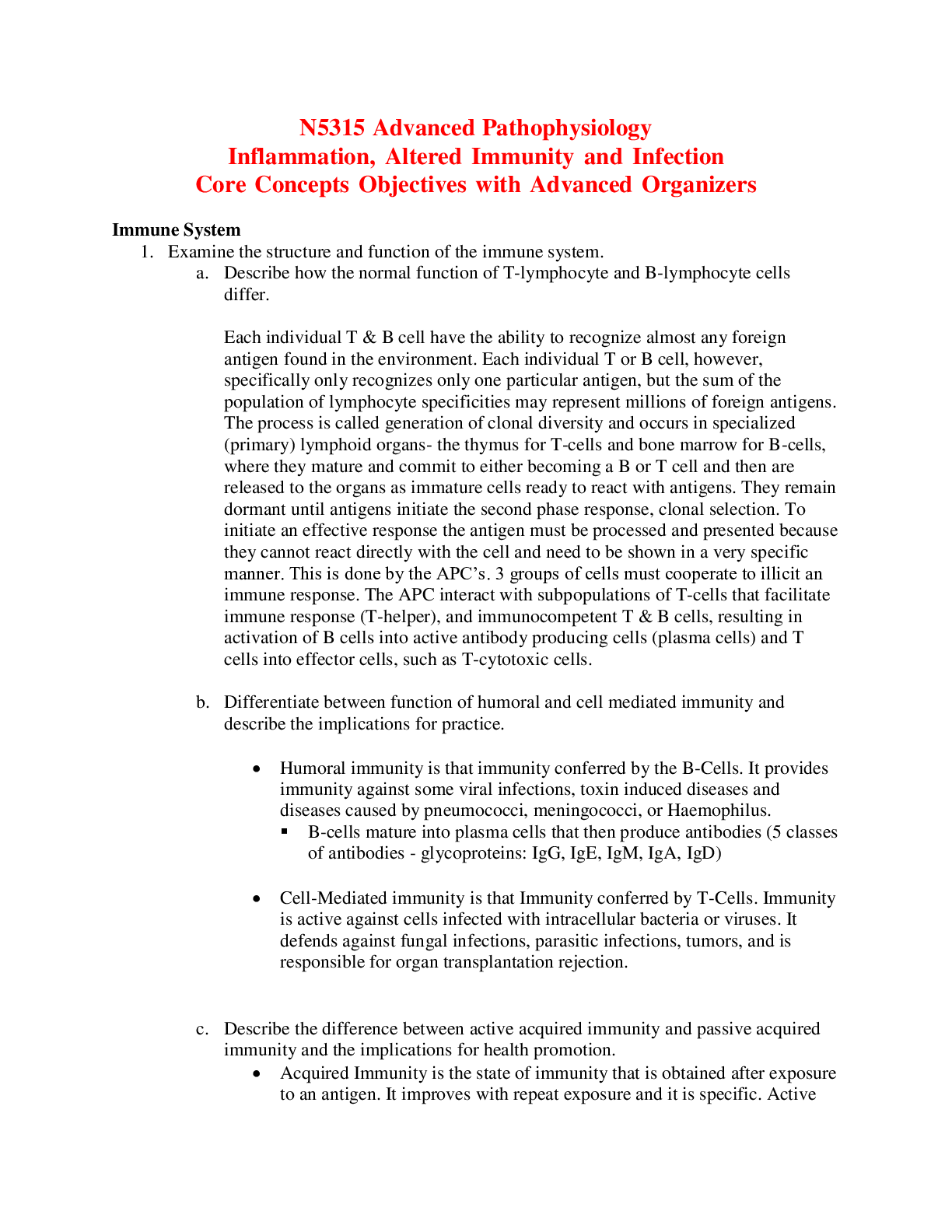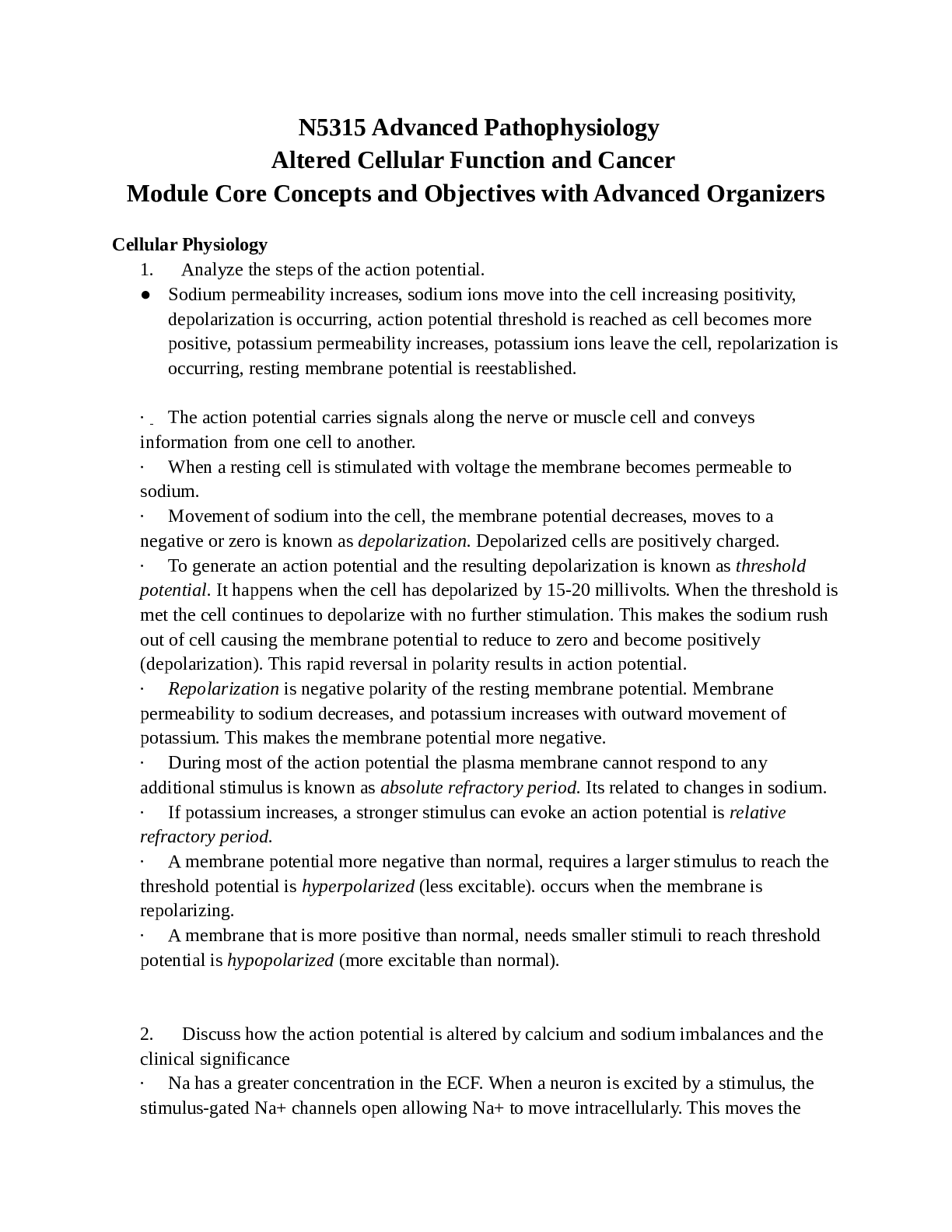Pathophysiology > EXAM > NURS 5315 Advanced Pathophysiology Gastrointestinal | Core Knowledge Objectives with Advanced Organi (All)
NURS 5315 Advanced Pathophysiology Gastrointestinal | Core Knowledge Objectives with Advanced Organizers
Document Content and Description Below
NURS 5315 Advanced Pathophysiology Gastrointestinal Core Knowledge Objectives with Advanced Organizers GI system- Module 9 Gastrointestinal Bleeds 1. Analyze the etiology, clinical manifest... ations, and pathophysiology of the upper and lower GI bleed and describe the implications this has for your clinical practice as a nurse practitioner. Disease Etiology Clinical Manifestations Pathophysiology Implications for Practice Upper GI Bleed Bleeding varices (varicose veins) in the esophagus or stomach, peptic ulcers, gastritis, or a Mallory-Weiss tear (tearing of esophagus from stomach) Frank, bright red or “coffee ground” (affected by stomach) emesis Hematemesis = bright red, bloody emesis= requires emergent intervention. Melena = black tarry. Shock symptoms if untreated: decreased CO, hypotension, ARF, tachycardia, and anemia. Any source of bleeding which occurs in the esophagus, stomach, or duodenum. If left untreated or if severe, can result in shock. Lower GI Bleed Inflammatory bowel disease, cancer, diverticula, or hemorrhoids Hematochezia: bright red blood in stools and the presence suggest bleed in lower track usually rectum, sigmoid colon, or descending colon. Any source of bleeding in the jejunum, ileum, colon, or rectum. Occult GI bleed is one that is not visible and results in iron deficiency. Type of bleed associated with colon cancer. = testing stools for occult blood Peptic Ulcer Disease 2. Analyze the etiology, clinical manifestations, and pathophysiology of gastric and duodenal ulcers and describe the implications for clinical practice. Disease Etiology Clinical Manifestations Pathophysiology Clinical Implications Gastric Ulcer s Ages 55-65, typically caused by NSAIDs. Chronic use of NSAIDs suppresses mucosal prostaglandin synthesis, resulting in decreased bicarbonate secretion and mucin production Epigastric pain which worsens when eating, melena, hematemesis or coffee ground emesis. Decreased mucosal protection or increased acid production. Infection with H. pylori. Complications include bleeding or perforation. If a perforation occurs, luminal contents can escape into the peritoneum and cause peritonitis. Treatment is similar to duodenal ulcer treatment. See p. 1437 Duodenal Ulcers Younger patients More common than any other type of ulcers Epigastric pain relieved by food. Pain will recur when stomach is empty, which may be 30min-2 hr after eating. Pain is relieved by eating food or antacids.Melena or hematemesis is also present Acid and pepsin concentration in the duodenum penetrating the mucosal barrier and lead to ulceration Endoscopic evaluation. Radioimmunoassay of gastrin levels to identify ulcers associated with carcinomas. Urea breath test. Management is aimed at relieving the causes and effects of acidity and preventing complications. Antacids, PPI, H2 blockers, eradication of H. pylori , ulcer coating agents such as sucralfate, surgical resection for perforation, obstruction or peritonitis. Risk of duodenal ulcers may be reduced with diet high in vit A and fiber. Disorders of the Intestines 3. Differentiate between the etiology, clinical manifestations, and pathophysiology of disorders of the small and large intestines. a. Analyze the etiology, clinical manifestations, and pathophysiology of ulcerative colitis and crohn’s disease and describe the implications on nutritional status. Disease Etiology Clinical Manifestations Pathophysiology Nutrition Implications Ulcerative Colitis Unknown origin, associated with genetic factors, alterations in epithelial cell barrier functions, immunopathology related to abnormal T cell reactions to commensal microflora and other luminal antigens Chronic, recurrent, bloody diarrhea. Febrile, polyarthritis, uveitis, sclerosing cholangitis, erythema nodosum, and pyoderma gangrenosum. Inflammatory disease of large intestine. Like Crohn’s it has periods of remission and exacerbations. Severe inflammation and ulcerations of large intestine which begins in rectum and involves entire large intestine. It only affects colon (not small intestine) and does not have skipped lesions no transmural inflammations and ulcerations = it remains superficial. Complications include toxic megacolon, colon perforation, and colorectal adenocarcinoma. Increase risk for colon cancer. Nicotine has a protective effect. In extreme cases IV fluids and IV nutrition Crohn’s Disease Affects persons in their 20s-30s and of Jewish descent. Causes include infectious agents (viruses or bacteria), autoimmune, psychosomatic, and impaired T-cell immunity. Abdominal pain, diarrhea, dehydration, bloody stools, malabsorption, malnutrition, weight loss (most nutrients absorbed in small intestine), intestinal obstruction from chronic inflammation, fistulas (abnormal tracts/channels that develop in the presence of inflammation), and perforation of the intestine. They can develop strictures which cause obstruction or fistulas between intestines, bladder, and vagina. Inflammatory disorder of GI tract with exacerbations and remissions. May affect any portion of the GI tract (mouth to anus) but most often in the ileum or proximal colon. Pathophys includes transmural involvement of the affected area (entire wall of the intestine is affected) and presence of skip lesions. This means that there are healthy, unaffected tissue surrounded by diseased tissue which are randomly present in the GI tract. Increased risk of colon cancer. If ileum is involved, one can have vit B12 deficiency anemia, folic acid and vit d and calcium. Loss of protein leading to hypoalbuminemia b. Compare the etiology, clinical manifestations, and pathophysiology of diverticulitis, diverticulosis, appendicitis, and bowel obstruction and describe the implications for clinical practice. Disease Etiology Clinical Manifestations Pathophysiology Clinical Implications Diverticulosis & Diverticulitis Associated with age >60 and lack of fiber, increased intracolonic pressure, abnormal neuromuscular function,and alteration in intestinal motility Symptoms may be vague or absent in 30% of those affected. Cramping pain in the lower abdomen. Diarrhea, constipation, distension, or flatulence. If inflammation or abscess develops, one can have fever, leukocytosis, and tenderness of the LLQ. Diverticular Disease is characterized as the presence of diverticula in the large intestine. Most common left colon. Diverticula are outpouchings of mucosa from the muscle layer of the intestine that protrude into the intestinal lumen. They most commonly occur in the sigmoid colon. Diverticulosis is the presence of diverticula in an asymptomatic individual. Diverticulitis is an inflammation of the diverticula and causes RLQ pain. can result in abscess formation, rupture and peritonitis. Bowel rest and antibiotics. Increase in dietary fiber. Surgical resection if there are severe complications such as hemorrhage or perforations. - - - - - - - - - - - - - - - - - - - - - - - - - - - - - Pyloric Stenosis More common in term white male babies. 1-2 weeks or 3-4 months. Increase of gastrin secretion by mother in 3rd trimester increases likelihood of pyloric stenosis. Increased incidence in babies who have a family member with pyloric stenosis. Unknown Hypertrophy of the sphincter muscle. Between 2-3 weeks after birth. Infant usually feeds well and is gaining weight and without apparent reason forceful projectile vomiting occurs immediately after eating. Vomit contains what was just eaten and no bile. Infants are hungry and want to eat after vomiting. Prolonged retention of food in the stomach (4 hrs) is characteristic of pyloric stenosis unless vomiting occurs. Firm, small, moveable mass the size of an olive is palpable at the RUQ in 70-90% of infants. Severe cases→ electrolyte imbalances ( hypokalemia, hypodchloremic metabolic acidosis), chronic malnutrition, weight loss. Infants become irritable, have esophageal discomfort from vomiting and may have blood tinged vomit from ruptured gastric or esophageal vessels. Circular muscle of pylorus is enlarged due to hypertrophy and hyperplasia. Lumen is narrowed by encroaching muscle. Due to increased peristaltic effort to get gastric contents into stomach through narrow pylorus, stomach may become hypertrophied. Neonatal Jaundice · Physiologic · Pathologic ABO rh incompatibility, prematurity, exclusively breastfeeding, maternal age > 25, male infants, delayed meconium passage, excessive birth trauma (bruising or cephalhematoma). Physiological- transient, benign that occurs in the first week of life in otherwise healthy full term infants. Pathological- appears in 24 hours with total serum bilirubin level > 20 or indirect bilirubin >15. Should be suspected if serum bili levels increase > 5 mg/dl per day, persistent jaundice (>7-10 days in full term infant). Physiological- develops during 2nd or 3rd day after birth and usually subsides in 1-2 weeks in full term infants and in 2-4 weeks in premature infants. Increasing bili levels beyond this time frame indicated pathological jaundice. Yellowing of skin, dark urine, light colored stools, weight loss. Premature infants with resp distress, acidosis or sepsis are at greater risk for encephalopathy. Disabilities of encephalopathy include athetoid cerebral palsy, speech and hearing problems. Physiological- Caused by mild unconjugated hyperbilirubinemia. Pathological- result from complex interaction of factors that cause: 1. Increase bilirubin production (hemolysis) 2. Impaired hepatic uptake of excretion of unconjugated bilirubin 3. Delayed maturation of liver conjugating mechanisms. Unconjugated bilirubin is lipid soluble, bound to albumin in blood and is able to cross BBB. Kernicterus or chronic bilirubin encephalopathy- deposits of toxic unconjugated bilirubin in brain cells. Late rising indirect bilirubin level may sign of glucose -6- phosphate dehydrogenase deficiency, an enzyme important in red blood cell metabolism. X linked genetic defect. Elevated unconjugated bilirubin levels can cause hemolysis → increasing jaundice even more. [Show More]
Last updated: 2 years ago
Preview 1 out of 44 pages

Buy this document to get the full access instantly
Instant Download Access after purchase
Buy NowInstant download
We Accept:

Reviews( 0 )
$14.50
Can't find what you want? Try our AI powered Search
Document information
Connected school, study & course
About the document
Uploaded On
Jan 17, 2021
Number of pages
44
Written in
Additional information
This document has been written for:
Uploaded
Jan 17, 2021
Downloads
0
Views
83








 – University of the People.png)
















